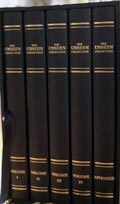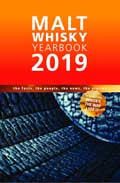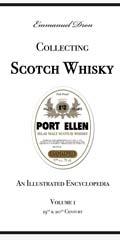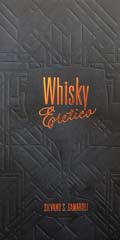
Whisky Sommelier: A Journey Through the Culture of Whisky, Massimo Righi, Davide Terziotti, and Fabio Petroni, White Star, 2020 It is an introductory book, explaining the manufacturing process of whisky and its history, as well as showing a selection of distilleries, including some of their whiskies (from the distillery owner or by independent bottler). It includes also tasting tips, histories of famous brands, receipe for cocktails and a very nice section of dishes. The photographs are superb and the illustrations very well made. It is rather well written and could be a very good introductory book about whisky and for the others, some good ideas of receipes. |
|
Everything You Need to Know About Whisky: (But are too afraid to ask), Nicholas Morgan & The Whisky Exchange, Ebury Press, 2021 When reading the title, I was rather skeptical, as I was scared of reading another generic introductory book about whisky. But browsing quickly through the book, with not a single diagram and photographs, this tells you that the book will be different. |
|
Johnnie Walker Long Stride: The Story of the World's No. 1 Scotch Whisky, Canongate Books, Nicholas Morgan, 2021 No one was best positioned than Nicholas Morgan to write the book about Johnnie Walker, who was in charge of setting up the Diageo archives at Menstries. This book traces the history of the brand, from its foundation in a grocery shop at Kilmarnock to the leading global brand of Scotch whisky. The book is very well written, clear and easy to read, with the right amount of details. Not only it provides a very good description of the brand and its evolution over 200 years, but also the evolution of the whisky industry during that period. The book is descriptive without being an advertising booklet. I just wished that more photographs were provided, otherwise, an excellent book. |
|
The Highland Coast (HC700) Whisky Guide, Spirit of the Glen, Alastair K Rooney, 2021 The High Coast 700 is a 700 British miles long is a beautiful scenic road in Scotland, going through Orkney, Skye and the Highlands. It is becoming very popular, and Alastair wrote this book to help visitors to make this journey, suggesting places to see, restaurants and of course whisky distilleries to visit. The book is concise, with very nice maps and rich in useful advices to plan your trip (like driving on small roads with a large vehicle). The book does not provide an exhaustive list of options, but proposes a nice suggestion. I like this option very much, as you do not need to spend hours to prepare your journey. His recommendations are made for a normal tourist, so that you can enjoy your time at the different stops, without rushing. Having been in most of these places, the selection made by Alastair is very good. I just wished it contained more photographs. Otherwise, an excellent choice if you plan to do the HC 700 or parts of it.
|
|
 |
Valentino Zagatti, The Unseen Collection, Hans & Becky Offringa, 2019 Rating: 4/5
|
Malt Whisky Yearbook 2020, 15th Edition, Ingvar Ronde, MagDig Media 2019 |
|
 |
Malt Whisky Yearbook 2019, Ingvar Ronde, MagDig Media 2018 With the rapidly changing whisky landscape, the Malt Whisky Yearbook is a must have. When going through this book, you realise how many new distilleries opened in 2018, not only in Scotland, but also in Ireland and over regions of the world. Due to weight constraints (with regards to shipping costs), the number of pages cannot be expanded. Thus, to account for all the new entries, the section on the world entries is more compact, as well as Japan. Maybe time to consider a “UK Malty Whisky Yearbook “ and a “World Whisky Yearbook edition”? A very highly recommended book for anyone who is trying up-to-date with the rapid changing whisky environment and a reference book that any retailer should have a hand reach. Furthermore, you can get all the production details and sales projections in this book as well. An excellent value book. The Malt Whisky Yearbook is maturing well. Rating: 5/5 |
Japanese Whisky: The Ultimate Guide to the World’s Most Desirable Spirit, Brian Ashcraft, Tuttle, 2018 |
|
 |
Collecting Scotch Whisky: An illustrated Encylopedia, Emmanuel Dron, 2018 I was very curious about this book, as I have heard a lot about it before. I finally managed to get my copy at Limburg. The retailer showed me how to open the book. But even so, when I opened it, the binding was already damaged and the spine went lose at the second opening. Unfortunately, the binding of this book is poor and the case looks rather cheap, with no covering of the cardboard inside, as in all the other books I own. The content is fortunately much better, with an impressive collection of bottles, including many that I have never seen before. In that respect, the work done by Emmanuel is impressive and the quality of the photographs very good. Layout is good to very good and the printing quality very good. For the bottles, the information is unbalanced between the brands, going through a rather comprehensive list of e.g., Cadenhead’s bottling, while it might be only some sentences on others. The amount of information on bottlers seems to be driven by Emmanuel’s interest and/or the amount of information gathered while preparing his book. In addition to the impressive amount of bottles displayed, there are several interviews. The book starts by useful information on how to date a bottle and how to identify fake bottlings, with some case studies. While attention is made on the bottle inspection and C14 dating, surprisingly there is no mention of the chemical fingerprinting, used for instance, in the case of the recent Fake Macallan in Switzerland. The part on the bottle code is very interesting. Unfortunately, no reference is provided about the source of information. In conclusion, it is the most comprehensive book on old bottles (prior to 2000) that I have seen so far, with an impressive amount of bottles displayed and high quality photographs. In addition, it contains for some companies (e.g., Cadenhead’s or Samaroli) a comprehensive list of bottlings, interviews and a good highlight on whisky identification. However, the quality of the binding is the worst I have seen so far, with no reinforcement whatsoever. For a book of this price (349 euros), this is disappointing and not acceptable. PS: The datation of the bottles is the result of the personal research made by Emmanuel, and not based on external sources. |
| My Name Is Whisky - Single Malt Scotch Whisky, Simon Paul Murat, Davide Terziotti, Fabio Petroni, MBookInternational, 2017 (EN) The book is impressive by its size and weight; 40.6cm x 29cm, and over 3 kg. The quality of the print is excellent and the sharpness of the full size bottles (approximately 640) is excellent, suggesting the use of a professional medium or large format photographs. The portraits are of the same professional quality. The bottles are mostly collectors bottled from the 20th (1900-1999) Century, and include most legendary whiskies, amongst which many Samaroli. The book contains several poems, and the text is mostly composed of interviews of whisky distillers, bottlers and collectors. The questions to the interviewees are sometimes repetitive and the layout inconsistent, with sometimes spaces between the questions and sometimes not. In addition, I noticed several typos, unclear sentences and even legends in Italian, which is would not expect from a book at this price.
|
|
The Malt Whisky Yearbook 2018, Ingvar Ronde, MagDig Media Ltd As a note, this section is not a comprehensive as the Scotch or Japanese section, and thus, you will not find information such as their production volumes. The final section provides a comprehensive summary of statistics and market growth. Looking at these figures, one might wonder how the future will look like in a couple of years, if volume sales are not growing as expected… Finally, the first section is a compilation of different articles from well-known whisky writers, with two articles, one on the stillmakers and new distilleries, that were particularly interesting. In conclusion, the 2017 edition does not disappoint, and as informative as always. I like the month of October for many reasons, with one being the release of this book that I read with pleasure every year from front to back. A great addition to your library or as a present to friends. Well-done Ingvar! Maybe, you might consider adding a on-line supplement as for scientific articles, to provide all materials that you could not fit in the book? A must buy for any whisky enthusiast. Rating: 5/5 |
|
Whisky Rising, the definitive guide to the finest whiskies and distillers of Japan, Stefan Van Eycken, Appleseed Press Book Publishers LLC, 2017
Rating: 4.5/5 |
|
Famous for a Reason: The Story of the Famous Grouse, Charles MacLean, Birlinn 2016 The first impression you get then your copies is delivered is the impressive weight: around 4.5 kg. It is now the heaviest whisky book I own. The number of pages is high (302 pages) and the format large (bigger than A4), with thick and heavy paper. No savings were made on the quality of the print, which is markedly better than the The Famous Grouse Whisky Companion. This book retraces the history of the Cloag Family and their whisky brand, the Famouse Grouse. While Charles MacLean goes sometimes quite deep in the genealogy of the Cloag Family, the book is very well written and provides a very good insight of the whisky industry from the late 19th century until today, including all the difficulties faced by a family owned company. The book is focused on the whisky brand, and only 1 page is written about the Glenturret distillery, the « home » of the Famous Grouse. While this book is richly illustrated with archives and photographs of bottles, there is not a single tasting note. In conclusion, an excellent book with a remarkable work done by Charles MacLean, not for only the fans of the brand, but for any whisky enthusiasts interested in the whisky history. Rating : 5/5 |
|
 |
Whisky Erotico, Silvano Samaroli, The Whisky Library (Hong-Kong), 2017 |
C. Ask Whisky 2- The Stories Behind the Whiskies: Volume 2, Rory Mhor Nicoll, CreateSpace Independent Publishing Platform , 2014 |
|
The art of whisky: A deluxe blend of historic posters from the Public Record Office, Jim Murray, Pro Publications 1998 Rating: 5/5 |
|
| Copyright © 2013-7 www.whisky-news.com. All Rights Reserved | |